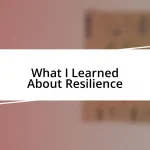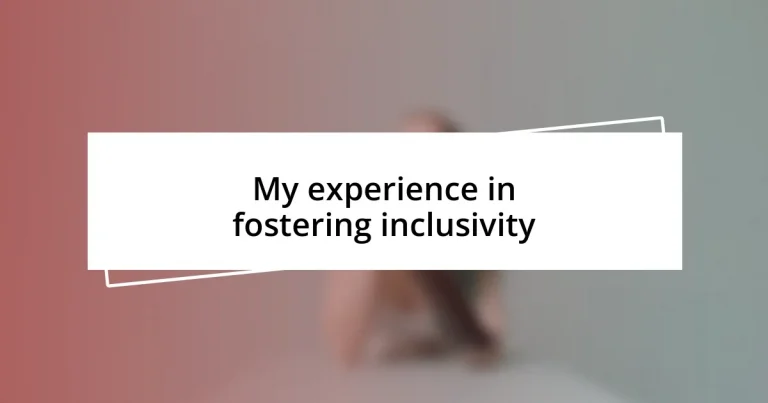Key takeaways:
- Inclusivity fosters a sense of belonging, enhances creativity, and transforms team dynamics by encouraging diverse perspectives.
- Effective strategies for fostering inclusivity include promoting open dialogue, diversifying team composition, and providing training on unconscious biases.
- Creating a welcoming environment involves small actions, clear communication, and celebrating diversity, which can strengthen relationships and community ties.
- Continuous improvement in inclusivity efforts requires open discussions, regular feedback, and creating safe spaces for vulnerability to build deeper connections.
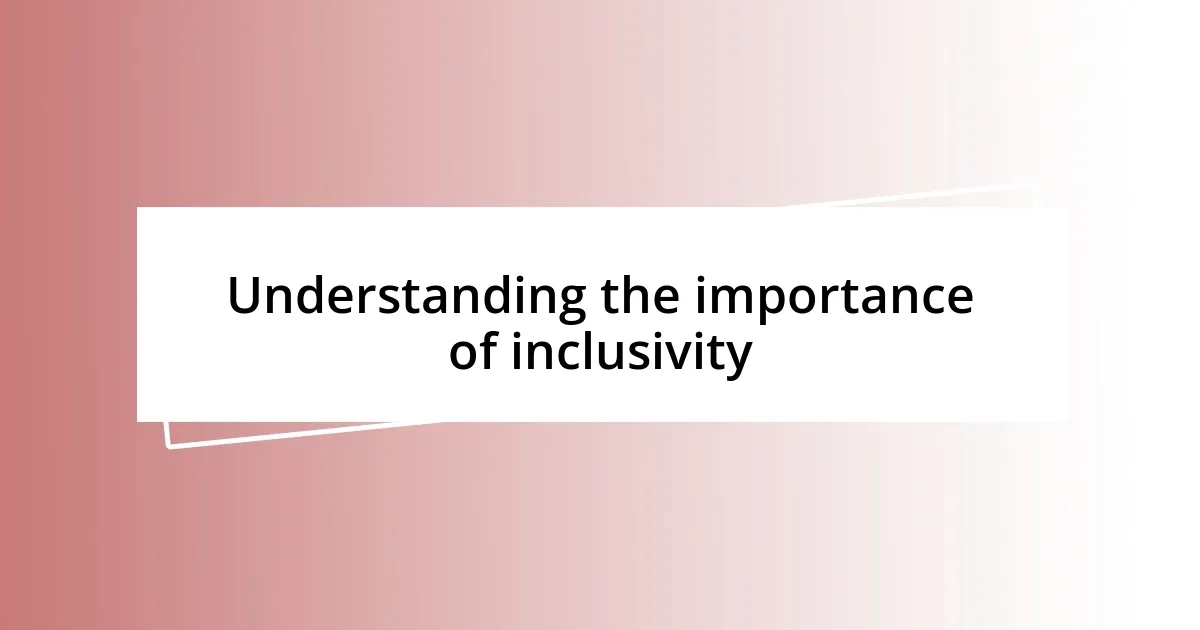
Understanding the importance of inclusivity
Inclusivity isn’t just a buzzword; it’s the foundation of a thriving community. I vividly remember attending a workshop where one participant shared their struggles feeling invisible in group settings. Listening to them, I realized how crucial it is for everyone to feel acknowledged and valued—imagine the impact of fostering that sense of belonging!
When I reflect on a team project I was part of, I see how inclusivity transformed our dynamics. Each voice mattered, leading to innovative solutions we never would have discovered if some felt sidelined. Have you ever been in a situation where you felt excluded? That feeling can stifle creativity and drain motivation, which is precisely why championing inclusivity is essential for any environment, whether it’s a workplace, a classroom, or a community gathering.
It’s not simply about policies or practices; it’s about human connection. I’ve seen firsthand how a simple gesture, like inviting someone to share their thoughts in a meeting, can open the door to deeper conversations and strengthen relationships. Doesn’t everyone deserve the chance to contribute to the dialogue? Fostering inclusivity is about making sure everyone—regardless of differences—can express themselves freely and fully.
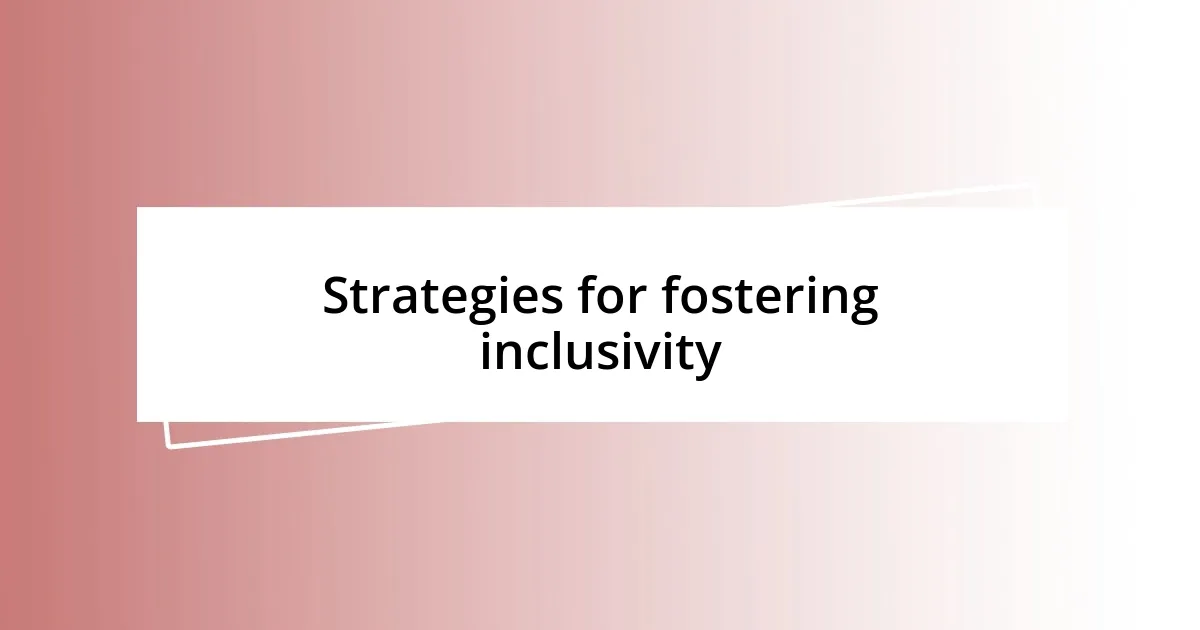
Strategies for fostering inclusivity
Creating an environment where inclusivity flourishes requires intentional strategies. One approach that has significantly impacted my experience is actively seeking diverse perspectives. In one project, I created a safe space for team members to express their ideas without fear of judgment. This not only empowered quieter voices but also led to breakthroughs we never anticipated. By prioritizing inclusivity, we turned potential conflict into collaboration, which was truly enlightening.
Here are some effective strategies I’ve implemented to foster inclusivity:
- Encourage Open Dialogue: Create platforms for everyone to share their thoughts freely.
- Diversify Team Composition: Bring together individuals from various backgrounds to enhance creativity.
- Set Clear Expectations: Make inclusivity a part of your core values and communicate this consistently.
- Train for Awareness: Provide training that focuses on recognizing unconscious biases and understanding different perspectives.
- Celebrate Diversity: Acknowledge and celebrate unique contributions to boost morale and strengthen community ties.
Each of these strategies has not only enriched my own understanding but has also made a tangible difference in the environments I’ve been a part of. It’s incredible how fostering an inclusive atmosphere can lead to powerful connections and collective growth.

Creating a welcoming environment
Creating a welcoming environment starts with small, deliberate actions. I’ll never forget the day I walked into a gathering where the setup was so inviting that I felt at ease instantly. Warm lighting, comfortable seating, and even name tags made it easy to connect with others. Isn’t it fascinating how these seemingly minor details can influence our comfort levels? It’s in these little touches that we show we care, setting the groundwork for meaningful relationships.
In my experience, clear communication is another pillar of a welcoming environment. I once attended a group discussion where the facilitator encouraged everyone to voice their opinions. It was transformative to watch the room shift from tension to collaboration as individuals began to feel empowered to speak up. Before that moment, I didn’t realize how powerful an atmosphere of openness could be. Have you ever felt the relief of finally sharing your thoughts in a supportive space? It’s a game-changer!
Moreover, embracing diversity is essential in creating inclusivity. I remember participating in a community event where diverse cultures were celebrated through food, music, and storytelling. This experience helped me appreciate different backgrounds, fostering connection and understanding among attendees. I believe that when people see themselves reflected in the environment, they feel valued. Isn’t that what everyone seeks—a space where they truly belong?
| Element | Importance |
|---|---|
| Warm Atmosphere | Encourages comfort and openness |
| Clear Communication | Fosters collaboration and empowerment |
| Diverse Representation | Creates a sense of belonging |
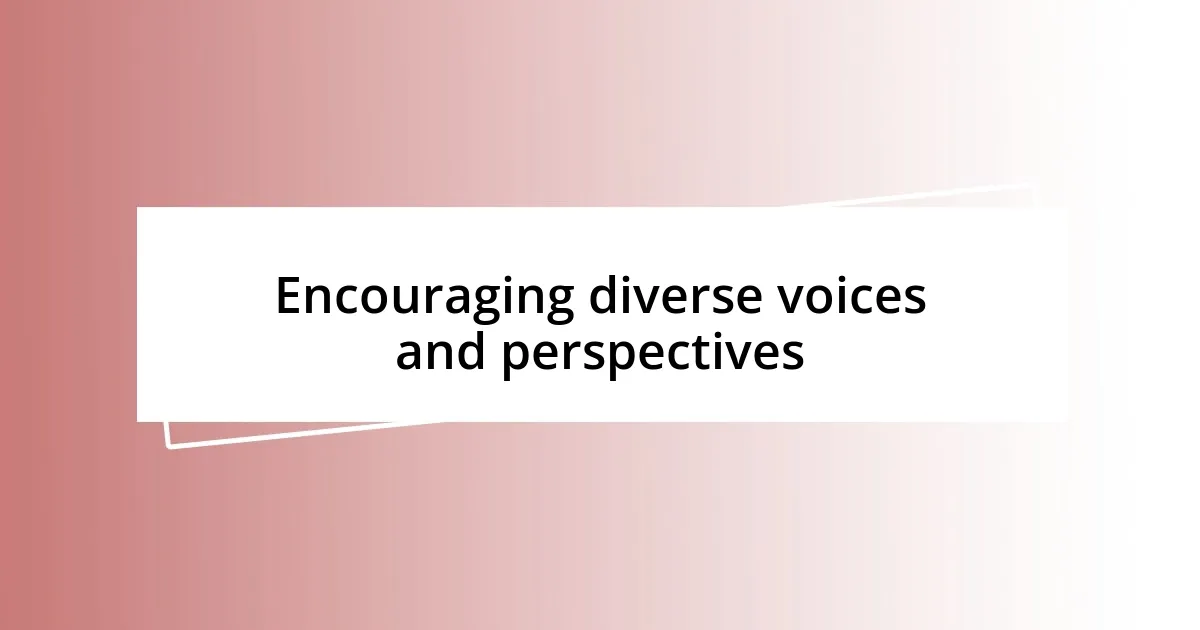
Encouraging diverse voices and perspectives
Encouraging diverse voices and perspectives has been a transformative experience in my journey towards fostering inclusivity. I recall a meeting where I invited a colleague from a different department to share their insights. Their unique approach not only inspired others but sparked a discussion that led to innovative solutions. It made me realize how essential it is to embrace contributions from varied backgrounds—everyone has valuable experiences that can illuminate new paths. Have you ever considered how a single perspective might change the direction of a project?
In another instance, I initiated “roundtable” discussions, where team members of all levels had the chance to share their thoughts openly. The energy was palpable; previously unheard ideas emerged, leading to unexpected breakthroughs. I remember a shy intern who, after much encouragement, shared a refreshing viewpoint on our strategy. When I saw their confidence blossom as their idea gained traction, it struck me how vital it is to create spaces where different voices can be celebrated. Can you imagine how many hidden gems we might overlook if we don’t cultivate those conversations?
Lastly, celebrating our differences has proven to be incredibly powerful. One memorable celebration involved sharing stories from our diverse backgrounds during a team lunch. The laughter and connections made in that space were heartwarming, and I found myself learning so much from my colleagues. When we intentionally share our narratives, we not only build relationships but also deepen our understanding of each other. Isn’t it fascinating how storytelling can bridge gaps and foster empathy among us?
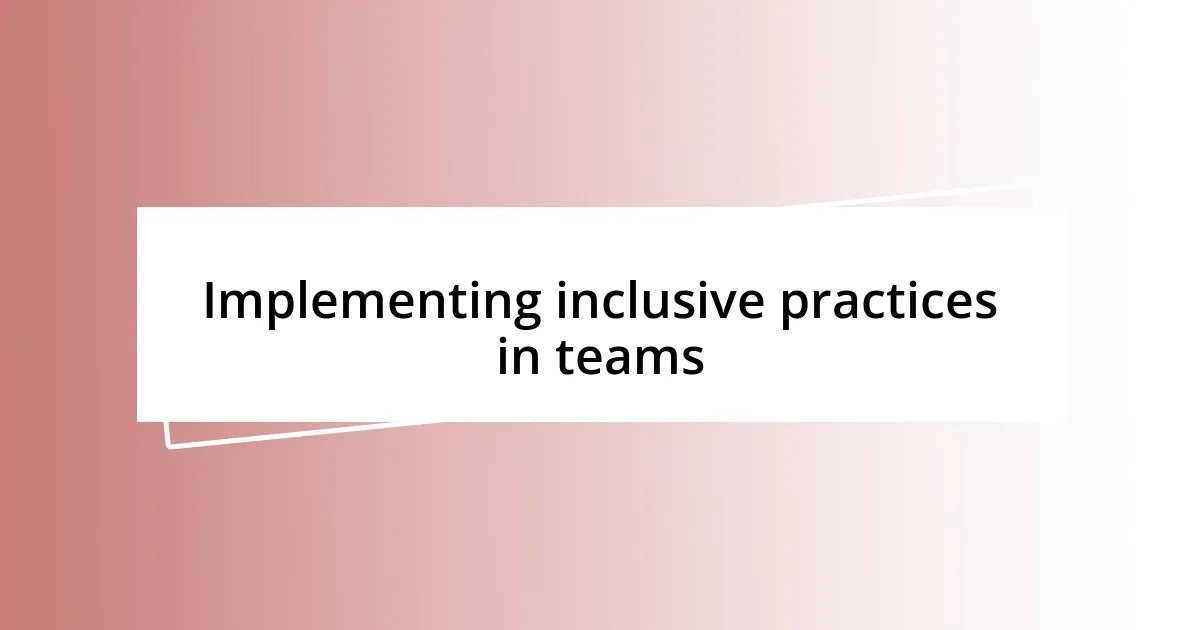
Implementing inclusive practices in teams
Implementing inclusive practices in teams requires a commitment to recognizing and valuing each team member’s unique contributions. I still remember the time I led a project where we consciously practiced active listening during updates. By encouraging everyone to share their thoughts without interruption, I witnessed a shift in team dynamics; an atmosphere of trust and respect emerged. Have you ever felt how simply being heard can motivate someone to engage more deeply?
Another significant practice I’ve embraced is providing opportunities for mentorship and growth. During one initiative, I paired experienced team members with newer colleagues, allowing for knowledge transfer and relationship building. It was rewarding to see confidence blossom in those who had previously felt sidelined. This experience taught me that investing in people is not just about tasks; it’s about nurturing potential. How often do we actively create pathways for others to shine?
Moreover, celebrating milestones—both big and small—can elevate team spirit and inclusivity. I recall celebrating our project completion with a potluck where everyone brought a dish representing their culture. The joy on people’s faces while sharing stories behind their dishes was extraordinary. It struck me how food can be an incredible connector in fostering community within teams. Don’t you think there’s something special about breaking bread together?

Measuring the impact of inclusivity
Measuring the impact of inclusivity can often feel like an intangible task, but I’ve found that gathering feedback can offer significant insights. For instance, after implementing a new inclusive strategy, I circulated an anonymous survey to gather team members’ feelings on their sense of belonging. The results were startling; many expressed that they felt more valued and engaged. Isn’t it incredible how numbers can provide such clarity into emotional experiences?
I remember a particular project where we set clear goals for inclusivity. Midway through, we conducted pulse checks to assess how well we were doing. The follow-up discussions revealed not just engagement levels but also a renewed sense of commitment to our collective goals. Seeing my colleagues connect over the shared vision invigorated me. Have you ever noticed how acknowledging progress can elevate a team’s morale?
Furthermore, I’ve noticed that measuring the impact goes beyond just data. It involves understanding the emotional landscape of the team. During reflection meetings, we shared personal stories of how inclusivity affected our work lives. Listening to my colleagues express their gratitude for the safer environment was genuinely moving. Have you ever felt the power of shared gratitude in reinforcing a culture? It reminded me that every small step we take is part of a larger journey towards fostering a genuinely inclusive atmosphere.
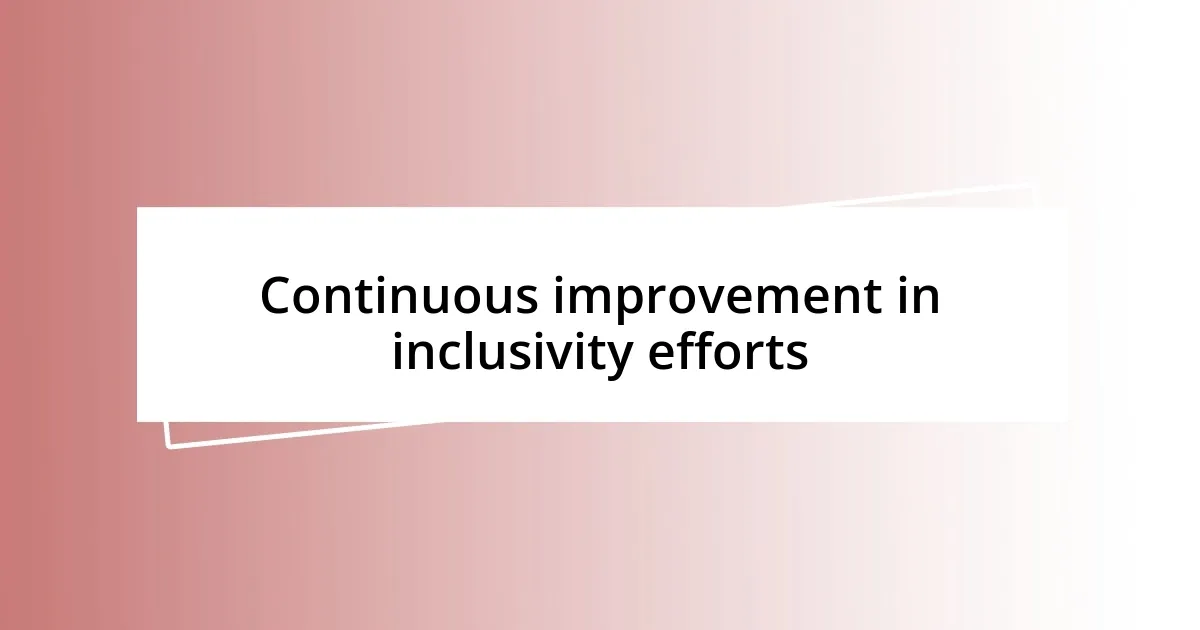
Continuous improvement in inclusivity efforts
One approach I’ve embraced for continuous improvement in inclusivity efforts is encouraging open dialogue about what inclusivity truly means for our team. I distinctly recall a meeting where we invited everyone to share their definitions and experiences. It was enlightening to see how diverse our perspectives were; some felt inclusivity was about accessibility, while others viewed it through the lens of cultural representation. Isn’t it fascinating how different backgrounds shape our understanding of the same concept?
I’ve also made it a point to integrate regular check-ins to assess our inclusivity strategies. On one occasion, I organized a casual coffee chat where team members could candidly share their thoughts on our established practices. The honest feedback revealed that some initiatives weren’t resonating as intended. This moment highlighted the importance of adaptability; it’s not enough to implement strategies—I’ve learned that we must also be willing to evolve them. Have you ever realized that listening can lead to unexpected revelations?
Moreover, I find that creating a safe space for vulnerability is critical. During a team retreat, I prompted everyone to share a time when they felt excluded and how they navigated that experience. The vulnerability that emerged was powerful, and it allowed us to connect on a more profound level. Seeing teammates open up about their struggles not only fostered empathy but also strengthened our commitment to each other. Have you experienced those moments that bring a team together like nothing else? It reaffirms that continuous improvement is about more than just policies; it’s about genuine human connection.
